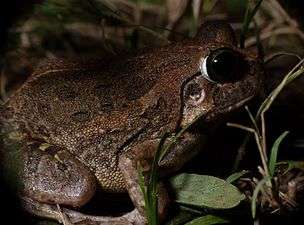Indian burrowing frog
The Indian burrowing frog (Sphaerotheca breviceps) is a species of frog found in South Asia (Bangladesh, Pakistan, Nepal, India, Sri Lanka and in Myanmar ).[2]
| Indian burrowing frog | |
|---|---|
 | |
| Scientific classification | |
| Kingdom: | Animalia |
| Phylum: | Chordata |
| Class: | Amphibia |
| Order: | Anura |
| Family: | Dicroglossidae |
| Genus: | Sphaerotheca |
| Species: | S. breviceps |
| Binomial name | |
| Sphaerotheca breviceps (Schneider, 1799) | |
| Synonyms | |
|
Tomopterna breviceps | |
Description
Its vomerine teeth form two oblique groups extending a little beyond the hind edge of the choanse. Its habit is stout. The head is short, with a rounded snout; the occiput is swollen, and the interorbital space is narrower than the upper eyelid. The tympanum is distinct, about two-thirds the diameter of the eye. The fingers are moderate and obtuse, with the first extending much beyond second, nearly as long as third; the toes are moderate, obtuse, and half-webbed; the subarticular tubercles are moderate, with the inner metatarsal tubercle being very large, sharp-edged, shovel-shaped, and longer than the inner toe; no outer tubercle or tarsal fold is present. The hind limbs are short, and the tibiotarsal articulation reaches the axilla or the tympanum. The skin above is smooth or granulate, with some scattered tubercles or short, interrupted longitudinal folds; a strong fold runs from the eye to the shoulder; the belly and lower surfaces of thighs are granulate. In color, it is light brown or olive above, with darker spots or marblings, often a light vertebral band, and sometimes another on the upper side of each flank; the throats of males are blackish, and those of females are usually brown-spotted. The male has two well-developed internal subgular vocal sacs.[3]
From snout to vent, it averages 2.5 inches.
It is found in the drier regions of India from the Punjab and Sind to southern India and Sri Lanka. In the Himalayas, it occurs up to about 7000 feet. The structure of the hind limbs enables this frog to burrow in the ground for about 1.5 feet.
Habitat
The habitat ranges from dry, arid land to moist deciduous forest. The microhabitat in which this frog is found includes leaf litter or under rocks, in crevices or in open spaces in arid areas.
References
- Ohler, A.; Khan, M.S.; van Dijk, P.P.; Wogan, G.; Dutta, S.; Inger, R.F.; Kumar Shrestha, T.; Manamendra-Arachchi, K. & de Silva, A. (2004). "Sphaerotheca breviceps". IUCN Red List of Threatened Species. 2004: e.T58755A86145885. doi:10.2305/IUCN.UK.2004.RLTS.T58755A11837725.en.{{cite iucn}}: error: |doi= / |page= mismatch (help)
- Frost, Darrel R. (2014). "Sphaerotheca breviceps (Schneider, 1799)". Amphibian Species of the World: an Online Reference. Version 6.0. American Museum of Natural History. Retrieved 2 March 2014.
- Boulenger, G. A. (1890) Fauna of British India. Reptilia and Batrachia
External links
- Sphaerotheca breviceps at AmphibiaWeb
- Sphaerotheca breviceps at Global Amphibians Assessment
